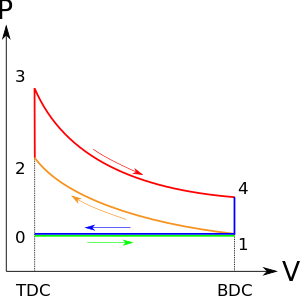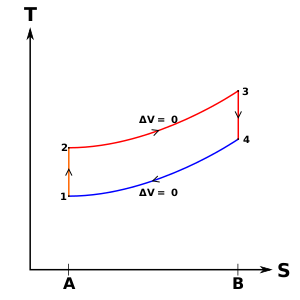
Back دورة أوتو Arabic Cicle d'Otto Catalan سوڕی ئۆتۆ CKB Ottův cyklus Czech Otto-kredsproces Danish Otto-Kreisprozess German Κύκλος Όττο Greek Ciklo de Otto Esperanto Ciclo Otto Spanish چرخه اتو Persian
| Thermodynamics |
|---|
 |


An Otto cycle is an idealized thermodynamic cycle that describes the functioning of a typical spark ignition piston engine. It is the thermodynamic cycle most commonly found in automobile engines.[1]
The Otto cycle is a description of what happens to a gas as it is subjected to changes of pressure, temperature, volume, addition of heat, and removal of heat. The gas that is subjected to those changes is called the system. The system, in this case, is defined to be the fluid (gas) within the cylinder. By describing the changes that take place within the system, it will also describe in inverse, the system's effect on the environment. In the case of the Otto cycle, the effect will be to produce enough net work from the system so as to propel an automobile and its occupants in the environment.
The Otto cycle is constructed from:
- Top and bottom of the loop: a pair of quasi-parallel and isentropic processes (frictionless, adiabatic reversible).
- Left and right sides of the loop: a pair of parallel isochoric processes (constant volume).
The isentropic process of compression or expansion implies that there will be no inefficiency (loss of mechanical energy), and there be no transfer of heat into or out of the system during that process. The cylinder and piston are assumed to be impermeable to heat during that time. Work is performed on the system during the lower isentropic compression process. Heat flows into the Otto cycle through the left pressurizing process and some of it flows back out through the right depressurizing process. The summation of the work added to the system plus the heat added minus the heat removed yields the net mechanical work generated by the system.
- ^ Wu, Chih. Thermodynamic Cycles: Computer-aided Design and Optimization. New York: M. Dekker, 2004. page 99
© MMXXIII Rich X Search. We shall prevail. All rights reserved. Rich X Search














